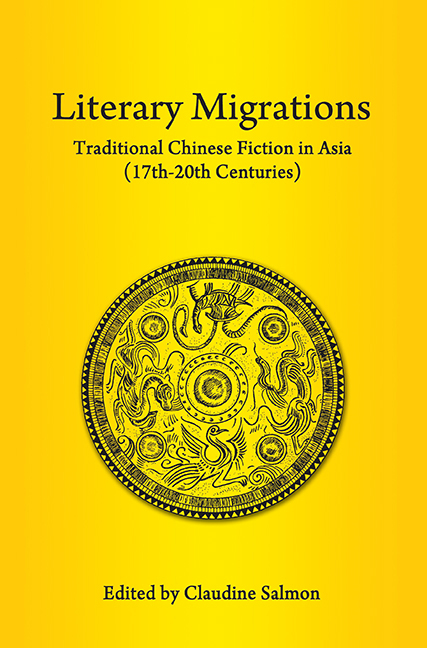Book contents
- Frontmatter
- Contents
- FOREWORD
- Dr Salmon as I Know her
- Preface to Reprint Edition
- Acknowledgements
- INTRODUCTION
- PART I KOREA AND JAPAN
- 1 The Influence of Chinese Stories and Novels on Korean Fiction
- 2 The Plots of Chinese Fiction in Korean Vernacular Novels
- 3 Chinese Colloquial Novels in Japan — Mainly during the Edo Period (1603–1867)
- PART II MAINLAND NORTHEAST ASIA
- PART III MAINLAND SOUTHEAST ASIA
- PART IV INSULAR SOUTHEAST ASIA
- Bibliography
- Author, story-teller and translator index
- Title index
- List of Plates
- Contributors
- Plate section
2 - The Plots of Chinese Fiction in Korean Vernacular Novels
from PART I - KOREA AND JAPAN
Published online by Cambridge University Press: 21 October 2015
- Frontmatter
- Contents
- FOREWORD
- Dr Salmon as I Know her
- Preface to Reprint Edition
- Acknowledgements
- INTRODUCTION
- PART I KOREA AND JAPAN
- 1 The Influence of Chinese Stories and Novels on Korean Fiction
- 2 The Plots of Chinese Fiction in Korean Vernacular Novels
- 3 Chinese Colloquial Novels in Japan — Mainly during the Edo Period (1603–1867)
- PART II MAINLAND NORTHEAST ASIA
- PART III MAINLAND SOUTHEAST ASIA
- PART IV INSULAR SOUTHEAST ASIA
- Bibliography
- Author, story-teller and translator index
- Title index
- List of Plates
- Contributors
- Plate section
Summary
The geographic position and the peculiarities of historical development of Korea account for the ties connecting this country with the cultural region of the Far East. In the beginning of the Christian Era Chinese characters were introduced, and Chinese literature began to spread in Korea (at first it was Confucian classics, Buddhist sūtras and Chinese poetry). At that time Korean literature came into existence, and Koreans began to translate Chinese works into their native language using Chinese characters as phonetic signs. The name of the first translator of Chinese literature into Korean is known to us: it was Sŏl Ch'ong (seventh c.)who “… read the Nine Classics in the native language”. The translation activity increased especially after the invention of the Korean script in 1446. Not only Buddhist and Confucian works, but also pieces of Chinese poetry were translated into the native language and commented upon. For instance, in 1481 poems by Du Fu with commentaries were published in Korean.
Besides “high” Chinese prose and poetry Chinese fiction was circulated in Korea as well. This kind of literature was regarded as “low works”, xiaoshuo (sosŏl in Korean)by the Far East traditional society. The extensive circulation of xiaoshuo during the seventeenth to eighteenth centuries in Korea was connected with the interest in the private life of a man and his place in the world that developed in the Korean society of the time. This interest at first was satisfied by the Chinese romances and short stories. Kim T'aejun characterizes “The Romance of the Three Kingdoms” (Sanguo zhi yanyi), “The Water Margin Story” (Shuihu zhuan)and “The Pilgrimage to the West” (Xiyou ji)as the most popular romances in Korea. These works circulated not only in the original Chinese, but also in Korean translations. Translations of this sort are voluminous manuscripts, which probably existed in a few copies only. W.E. Skillend, the English investigator of Korean literature, in his “Survey of Korean Traditional Style Popular Novels” writes about single copies from the Former Palace Library; in other cases he refers to authors who have mentioned such manuscripts. Perhaps such translations were specially commissioned. For instance, Skillend informs us about Yi Chongt'ae (nineteenth c.)who translated Chinese romances by royal command. Unfortunately, I have none of those translated works at my disposal.
- Type
- Chapter
- Information
- Literary MigrationsTraditional Chinese Fiction in Asia (17th–20th Centuries), pp. 61 - 72Publisher: ISEAS–Yusof Ishak InstitutePrint publication year: 2013



